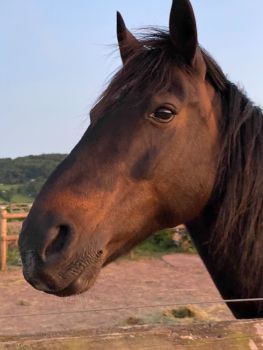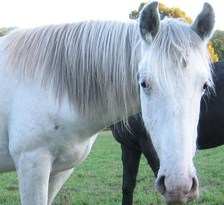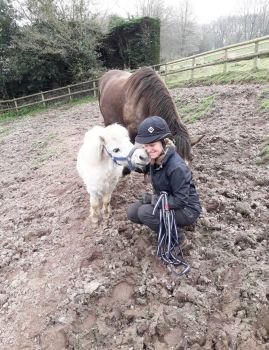Case Studies
CATCHING:
FIRST HEAD COLLAR:
FOOT HANDLING:

Harley
An 18 month old Appaloosa.

Harley's owner Helen, bought Harley unintentionally! Helen went to view a coloured horse for sale, who was advertised as a nice quiet hack, and whilst there heard a noise coming from a disused railway carriage, near to where she was viewing the coloured horse. After enquiring what the noise was and being told it would be nothing of interest to her, curiosity got the better of her and she virtually insisted on knowing what was in there. When the door was opened, to her horror she found that the carriage had been split into 2 and a little white nose peered out at her followed by some tiny little eyes that obviously hadn't seen daylight for a while. It was a 6 month old Appaloosa foal, that had recently been weaned. "I'll take this one" she said. Helen had immediately fallen in love with this poor little foal and couldn't wait to take him away. Unfortunately that wasn't to be the case for quite a few days as she had to arrange a time that they could bring him over to her and she had to make arrangements at her end.
Harley was delivered a few days later in a sheep trailer, chained to a sheep gate at the back of the trailer and was not in the best of condition. He was very ribby and covered in lice. His coat was extremely matted in places especially all over his belly which was covered in his own dung.
I was called in after Helen had not suprisingly discovered that he was difficult to catch! With much committment, and determination Helen followed my training plan and eventually Harley became easy to catch. His lice were treated and cleared up and he soon began to put on some weight and gain confidence.
Below is a video clip of Harley at 18 months old during a training session with me. He is leading beautifully and learning to back up through L shaped poles.
Having influence over every direction that your horse's feet can move in, means that you have influence of your horse.
I have found that teaching a horse to `back up' is one of the most useful training exercises that you can do. When as a handler we ask the horse to back up, we are showing the horse that we have control of this movement; the horse no longer owns that movement and so therefore is less likely to use it against us, ie. nappy behaviour or rearing.
It should also be considered that the horse has to really trust you in the `backing up' process as they cannot see where they are going due to there being a blind spot directly behind them.
Also 'backing up' is a useful tool when it comes to loading a difficult horse which I discuss more later on.
The exercise also has the added bonus of teaching you to be able to manoeuvre the horse accurately whilst in reverse, teaching you about how what you do with your body affects what they do with theirs.
Following on from the backing up exercise, I trained Harley to walk over tarpaulin in preparation for loading. I wanted him to trust me enough to walk with me across a noisy, strange surface in preparation for the ramp.
Here is a clip of Harley at the start of the session, initially refusing to walk over the tarpaulin.
Ok, so he jumps it! but never-the-less a step in the right direction. I gradually opened out the tarpaulin bit by bit and continued working with Harley until he was placing all 4 of his feet on it and walking across calmly. Eventually Harley walked over the full size of the tarpaulin which is shown on the video clip below.
The next step was to introduce Harley to loading. This was done on a separate day.
Here is a very short clip of Harley being shown the vehicle for the first time. He is wearing a heart rate monitor so I could see what he was experiencing on the inside. He clearly did not want to load and was very tentative and nervous of what was being asked of him.
This next clip shows Harley daring to put his front feet on the ramp. To him a wierd sloping green thing that definitely isn't grass and with what looks like snakes lying across it, AND it makes a funny sound when stepped on ....
And finally here is a clip of Harley showing a huge amount of trust as he loads beautifully, manages the turn very gracefully and then calmly walks off.
I loaded Harley off and on a further four times to let him see all was ok and to allow for his heart rate and adrenaline to fall. A low adrenaline means an increase in learning.
The total length of the session was just under 9 minutes including the extra four loading practices.
The success of this was down to all the preparation that had happened beforehand. Harley had learnt how to lead beautifully, respect the handler's personal space and had built up trust and confidence through the tarpaulin and pole exercises.
One question which might spring to mind whilst watching these clips, might be:
'Why on earth does she keep asking Harley to back up, when obviously he needs to go forwards to be able to load?
Surely that is teaching him to run backwards or to refuse to go in?'
As mentioned above backing up is useful to help build trust and to show the horse we have influence over this movement, so they are less likely to use this as an evasion. Rearing and napping can evolve over not having influence over this movement.
`Backing up' is physically not a a very natural movement for the horse to perform. Anatomically being a flight animal they are of course designed to go forwards, backing up is therefore harder work, so we can use this to create a contrast with the ease of going forwards being the much more desirable and easiest option.
Other interesting heart rate results: a considerable lowering of the heart rate occured when I gave Harley a rub/stroke on the forehead. This is an area that they can't see and so by giving a stroke in this area and then coming away again is a very non predatory action which can help to build trust.
Sighing also produced a lowering of the heart rate.
Licking and chewing produced a lowering of the heart rate, as Harley showed signs of relaxing.
Standing still also produced a lowering of the heart rate, which I did with Harley in between practice loads and as a rewards when he was being particularly responsive.
Backing up produced a raise in heart rate understandably.
A rise in Harley's heart rate was seen when he put just his front feet on the ramp and when he was walking up the ramp, which one would perhaps expect.
Although I didn't see this with Harley, other interesting findings through other horses that I have loaded whilst using a heart rate monitor have shown that the heart rate reduces significantly when the horse refuses off to the side of the ramp, or just plants their feet at the foot of the ramp. This I believe is due to the horse feeling that they have control of their feet, as he/she plants themselves.
It should be considered that the heart rate may not be low in the case of a horse that is refusing to load because he/she is genuinely fearful, perhaps due to a bad experience of either travelling or being made to load forceably.
You may also be interested to know that the following 4 loads that Harley did saw heart rates of 105bpm and 83bpm, being comparible to that of a horse in a fast trot, and also 90bpm and 70bpm, comparable to that of a horse in either walk or a slow trot.
Harley's 'activity between heart beats' result showed him to be quite high and yet he displayed no obvious behavioural signs to suggest that he was particularly stressed by the situation. An interesting result to think about.
Horses and ponies being flight animals means that if adrenaline levels are raised then their instinct is to flee, not think. With a raised adrenaline their ability to learn is severely diminished.
Unclear communication, fear and pain are the main two culprits for raising adrenaline in the horse.
By learning the horse's language and psychology, so many problems can not only be solved but avoided.
It is possible to get a horse to do pretty much anything, but my aim is always to get the horse`to want to', this is at the heart of developing a great bond and relationship with your equine partner.
Harley is now on the right road (literally!) to success in all that he does. Helen continues to regularly introduce Harley to new things and experiences, making sure she is setting things up for his success. She is enjoying learning all about his language and psychology and their relationship has gone from strength to strength which is lovely to see.
Seren
Seren is a beautiful, very sensitive Welsh Section D mare.
This short video shows me working with Seren in my round pen. Seren is doing a fantastic job of demonstrating beautiful ground manners, and what one would ideally be aiming for with regards to safe leading of their horse or pony.
I start by having a long lead rope clipped on so that I can sculpt her using 'pressure and release' where necessary, to where I want her to be which is ideally with her nose in line with my shoulder and a good arms length away from me which keeps me out of her flight path!
When I remove the line you can see she is still very happy to follow me and for me to be her leader - this is simply because I have worked with moving her feet in every direction and never allowing her to move my feet; Seren therefore sees me as her leader and a safe place to be.
A great place in the relationship to start any kind of work or training from.
Maisie
Maisie is a beautiful, 9 year old Welsh Section A who came to me to be backed and made safe for a child/children to ride. This video clip shows me training Maisie to stand still if the rider falls off - we covered every combination that I could think of!
Here is a little clip showing that it is possible for pony's to behave when working on grass - you just need absolute consistency.
If they sometimes get grass from pulling their head down and sometimes they don't then the grass snatching can become really addictive as sometimes it works and sometimes it doesn't, a bit like gambling can become to a human. If you always lost when gambling it would quickly loose its appeal, and because you had no pay off for doing it then it would quickly become something you couldn't really see any point or fun in doing, but you'd only have to win once to start thinking it might be a good idea to try again. It's the same mindset with ponies and grass. If they never succeed then they quickly learn that there is no point in trying.
Some times according to the nature of the pony it may be possible to set up a cue such as patting the ground to say it's OK to eat now, but not in all cases, and again you would need to be incredibly consistent with this for it to really work. Anyway here is the clip showing Maisie ground tied and being as good as gold!
And lastly just a quick note about hand feeding. I always recommend that you NEVER hand feed your pony or horse. Feeding by hand as in from your hand encourages biting. Next time you give your horse or pony a feed in a feed bowl note how they treat the BOWL, quite often they continue to bite the bottom of it in search for more food that the bowl produced. I have a pony who throws his bowl after biting the bottom of it when empty. They have no respect for the bowl, and its the same for your hand, they may continue to bite the bottom of your hand or become very pushy towards you if they start to see you as the HUMAN BOWL. Pony's and horses walk all over grass and hay, its there for them generally in abundance and as Monty Roberts always says, 'no blade of grass has ever run from a horse' so grass isn't seen in their eyes as a reward or trophy like say for example hunting is to a predator .
Another useful tip is to avoid playing with your horse's muzzle and mouth. Constant touching and stroking of this area is so annoying for them and it is just reinforcing that it is OK for the pony or horse to touch you with this area. Their mouth and muzzle are like our fingers, they explore things with them. After the touch usually comes the teeth, not necessarily in an aggressive way but in an exploring way. So, don't be suprised if after touching you gently with their mouth (which you may have encouraged them to do) the teeth appear, best to not encourage this behaviour in the first place by drawing a clear boundary just so there is no chance of confusion. Just some food for thought!
Harry the most flyspray phobic horse that I have ever worked with!
Here is the before and after video.
download my FREE PDF guide 10 steps to flyspray success including the full 5 training sessions video series over 5 days by email, which I hope is helpful.
